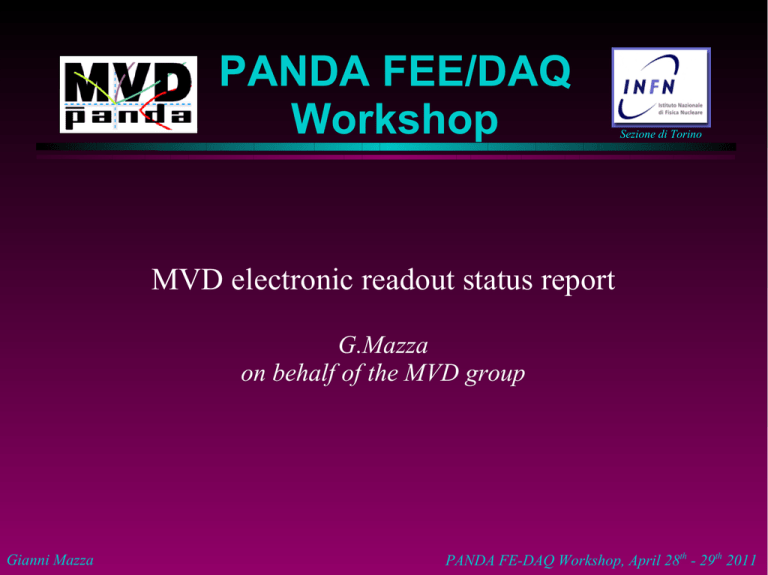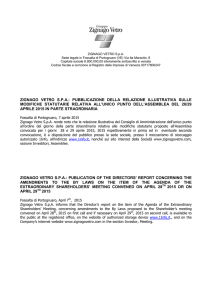Slides - Indico
advertisement

PANDA FEE/DAQ Workshop Sezione di Torino MVD electronic readout status report G.Mazza on behalf of the MVD group Gianni Mazza PANDA FE-DAQ Workshop, April 28th - 29th 2011 PANDA MVD Sezione di Torino ✵ Barrel : Layer 1 : radius 28 mm, SPDs Layer 2 : radius 53 mm, SPDs Layer 3 : radius 92 mm, SSDs Layer 4 : radius 120 mm, SSDs ✵ Forward : Disks 1-2 : radius 37.5 mm, SPDs Disks 3-4 : radius 75 mm, SPDs Disks 5-6 : radius 130 mm, SPDs + SSDs Gianni Mazza PANDA FE-DAQ Workshop, April 28th - 29th 2011 Pixel detector Sezione di Torino PIXEL DETECTOR D. Calvo1, P. De Remigis1, T. Kughatasan1,2, G. Mazza1, A. Rivetti1, L. Toscano1, R. Wheadon1 1 INFN sez. di Torino 2 Universita` di Torino Gianni Mazza PANDA FE-DAQ Workshop, April 28th - 29th 2011 Pixel specs Sezione di Torino Pixel size Chip active area dE/dx measurement Max input charge Noise floor 11.4 × 11.6 mm2 (116 rows, 110 cols) ToT, 12 bits dynamic range 50 fC <32 aC (200 e-) Clock frequency 155.52 MHz Time resolution 6.45 ns ( 1.9 ns r.m.s. ) Power consumption Max event rate Total ionizing dose Gianni Mazza 100 × 100 μm2 < 500 mW/cm2 see next slide < 100 kGy PANDA FE-DAQ Workshop, April 28th - 29th 2011 Data rates (worst case scenario) Sezione di Torino antiproton- proton (disk) Au (barrel) Particle rate per cm2 · s 6 · 106 1.6 · 106 Data rates per cm2 (per chip )[Mb/s] : no multiple hit (avg) multiple hits, 100 μm sensor (avg) multiple hits, 200 μm sensor (avg) multiple hits, 100 μm sensor (max) multiple hits, 200 μm sensor (max) 300 (397) 450 (595) 750 (992) 675 (893) 1125 (1488) 80 (110) 120 (160) 200 (260) 180 (240) 300 (398) Gianni Mazza Chip sensitive area : 1.32 cm2 Avg rate : 20 ·106 annihilations/s Max rate : 30 ·106 annihilations/s PANDA FE-DAQ Workshop, April 28th - 29th 2011 Routing direction Sezione di Torino Gianni Mazza PANDA FE-DAQ Workshop, April 28th - 29th 2011 Module concept Sezione di Torino Gianni Mazza PANDA FE-DAQ Workshop, April 28th - 29th 2011 Module types Sezione di Torino 4 chips/module 2 chips/module 5 chips/module Gianni Mazza 6 chips/module PANDA FE-DAQ Workshop, April 28th - 29th 2011 Readout scheme Sezione di Torino Module controller Bus Detector Readout ASIC Option 1 LVDS bus Service board : ➔ Optical transceiver ➔ Voltage regulator ➔ DCS Bus Detector Readout ASIC SLVS bus Gianni Mazza Option 2 PANDA FE-DAQ Workshop, April 28th - 29th 2011 Readout options Sezione di Torino ✵ ✵ Gianni Mazza Option 1 reduced number of cables simpler ToPiX control logic better management of data rate increase requires an extra chip Option 2 no need of an extra chip interface already under development at CERN more cables PANDA FE-DAQ Workshop, April 28th - 29th 2011 ToPiX ASIC Sezione di Torino ✵ Custom development for the PANDA MVD ✵ Provides spatial and time coordinates plus energy resolution measurement ( via ToT ) ✵ Compatible either with p-type or n-type detectors ✵ Self triggered architecture ✵ Each event has a 12 bits time reference ✵ Double rate serial readout ✵ Radiation tolerant ✵ Data corresponding to a 12 bits counter cycle (26.21 μs ) are packed in a frame, with an 8 bits frame counter ( 6.71 ms cycle ) Gianni Mazza PANDA FE-DAQ Workshop, April 28th - 29th 2011 Pixel cell Sezione di Torino Gianni Mazza PANDA FE-DAQ Workshop, April 28th - 29th 2011 ToPiX block diagram Sezione di Torino Double column structure Common time reference Readout data : Address Leading edge time Trailing edge time End of column buffering Serial data out Gianni Mazza PANDA FE-DAQ Workshop, April 28th - 29th 2011 Data format Sezione di Torino Gianni Mazza PANDA FE-DAQ Workshop, April 28th - 29th 2011 ToPiX v2 architecture Sezione di Torino 0 Pixel 125 Column 0 Data Pixel 124 Column 1 128 cells Pixel 0 Busy Counter/Shift Gianni Mazza Sense amplifiers Output bus Column 3 32 cells Column 2 32 cells Pixel 126 Address Time stamp/configuration bus Pixel 127 ■ Full pixel cell ( analogue + digital ) ■ Two folded columns with 128 cells ■ Two columns with 32 cells ■ 5x2 mm2 die area ■ CMOS 0.13 µm technology ■ SEU tolerant logic (based on the DICE cell) PANDA FE-DAQ Workshop, April 28th - 29th 2011 ToPiX v2 Sezione di Torino ToPiX prototype 5 mm × 2 mm Pixel cell 100 μm × 100 μm Analog Gianni Mazza Digital PANDA FE-DAQ Workshop, April 28th - 29th 2011 ToPiX v2 Sezione di Torino Tests : ✵ electrical ✵ connected to a detector via wire bonding ✵ TID tests ✵ SEU tests References : D. Calvo et al, A Silicon Pixel Readout ASIC in CMOS 0.13 µm for the PANDA MicroVertex Detector , Nuclear Science Symposium Conference Record, 2008 IEEE, 19-25 Oct. 2008 Page(s): 2934 – 2939 D. Calvo et al., The silicon pixel system for the Micro Vertex Detector of the PANDA experiment – doi:10.1016/j.nima.2009.09.043 T. Kugathasan, et al., Front end electronics for pixel detector of the PANDA MVD - Proceedings of the Topical Workshop on Electronics for Particle Physics 21-25 Sep 2009 - Paris, France - CERN 2009-006, pag. 52-56 Gianni Mazza PANDA FE-DAQ Workshop, April 28th - 29th 2011 ToPiX v3 Sezione di Torino Layout submitted on February 7th – expected for May 4.5x4 mm2 die area CMOS 0.13 µm DM technology LM → 6 thin, 2 thick metal layers DM → 3 thin, 2 thick, 3 RF metal layers Triple redundancy-based SEU protection End of column logic 160 Mb/s SLVS serial output Pads for bump bonding Gianni Mazza PANDA FE-DAQ Workshop, April 28th - 29th 2011 Cell layout Sezione di Torino ToPiX v2 Analogue Gianni Mazza ToPiX v3 Digital Analogue Digital PANDA FE-DAQ Workshop, April 28th - 29th 2011 Double cell Sezione di Torino Analogue part left Digital part left Digital part right Analogue part right Common bus Gianni Mazza PANDA FE-DAQ Workshop, April 28th - 29th 2011 ToPiX v3 layout Sezione di Torino Gianni Mazza ✵ 4.5 mm × 4 mm ✵ CMOS 130 nm ✵ Clock frequency 160 MHz ✵ bump bonding pads ✵ 2×2×128 columns ✵ 2×2×32 columns ✵ 32 cells EoC FIFO ✵ SEU protected EoC ✵ Serial data output ✵ SLVS I/O PANDA FE-DAQ Workshop, April 28th - 29th 2011 End of column Sezione di Torino Gianni Mazza PANDA FE-DAQ Workshop, April 28th - 29th 2011 SLVS Sezione di Torino CERN development ( S. Bonacini ) SLVS Driver test with Al cables ongoing Gianni Mazza PANDA FE-DAQ Workshop, April 28th - 29th 2011 GBT Sezione di Torino Gianni Mazza PANDA FE-DAQ Workshop, April 28th - 29th 2011 GBT chipset Sezione di Torino Radiation tolerant chipset : Target Applications : ✵ GBTIA : Transimpedance optical receiver ✵ Data readout ✵ GBLD : Laser driver ✵ TTC ✵ GBTx : Data and Timing Transceiver ✵ Slow control and monitoring links ✵ GBT-SCA : Slow control ASIC Supports : Radiation Tolerance : ✵ Bidirectional data transmission ✵ Total dose ✵ Bandwidth : ✵ Single Event Upset Gianni Mazza → Line rate : 4.8 Gb/s → Effective : 3.36 Gb/s PANDA FE-DAQ Workshop, April 28th - 29th 2011 Power regulator Sezione di Torino ✵ ToPiX power supply 1.2 V – IDC ~ 500 mA ( estimated ) → voltage drop on cables is not negligible ✵ A DC-DC converter solution compatible with the radiation levels and the magnetic field of a silicon tracker is under development @ CERN for sLHC ✵ Current CERN version : VIN 10÷12 V, VOUT=1.8÷3.3 V, IOUT < 3 A ✵ VOUT=1.2 V seems feasible ✵ Board position t.b.d. → ToPiX internal regulator t.b.d. Gianni Mazza PANDA FE-DAQ Workshop, April 28th - 29th 2011 Conclusions Sezione di Torino ✵ A pixel readout architecture has been defined – waits for more detailed rate simulations to be finalized. ✵ F/E ASIC with full pixel cells and columns has been designed and tested – a new prototype, with full end of column logic has been submitted to foundry. ✵ A GBT-based interface to the DAQ system is under evaluation. Contacts with the CERN GBT group ongoing. ✵ Started discussion with a CERN group for radiation tolerant DC-DC converter. A solution based on the AMIS ASIC is under evaluation. Gianni Mazza PANDA FE-DAQ Workshop, April 28th - 29th 2011 Next steps Sezione di Torino ✵ Test of ToPiX v3 ✵ Simulations of the ToPiX updated architecture with the data ← input from simulations ( L. Zotti ) ✵ ToPiX more accurate power estimation ( from v3 tests ) → input to cooling design ( S. Coli ) ✵ 1st approximation definition of the data trasmission board and the power regulator board → input to mechanical design ( G. Giraudo ) ✵ New aluminium cables testing with SLVS drivers Gianni Mazza PANDA FE-DAQ Workshop, April 28th - 29th 2011 Front­end for the MVD­strip­detector PANDA FEE/DAQ/Trigger Workshop Grünberg - April 28/29, 2011 Requirements ● ● ● unique requirements for PANDA: • self triggering • precise time resolution • fully digital hit information digitization of hit amplitude: • ADC • ToT low power consumption PANDA FEE/DAQ/Trigger Workshop Grünberg - April 28/29, 2011 Options ● adapted ToPix3 ● STS-XYTER ● (modified) FSSR2 ● development by Marek Idzik et al. PANDA FEE/DAQ/Trigger Workshop Grünberg - April 28/29, 2011 ToPix3 ● ● ● ● front-end chip of the pixel detector developed in Turin possible adaptation of analog circuits for strip detectors would provide comparable readout structures between pixel and strip part currently not carried forward due to lack of personnel PANDA FEE/DAQ/Trigger Workshop Grünberg - April 28/29, 2011 STS­XYTER ● ● ● ● development by R. Szczygiel et al., AGH Krakow self triggered architecture low power and low resolution dedicated for silicon strip detectors ToT-based digitization PANDA FEE/DAQ/Trigger Workshop Grünberg - April 28/29, 2011 FSSR2 ● developed for BTeV ● fully digital front-end ● peaking time and gain selectable ● 3-bit Flash-ADC with selectable thresholds ● but: time stamping with beam crossing time of 132 ns PANDA FEE/DAQ/Trigger Workshop Grünberg - April 28/29, 2011 Readout­Controller design for the MVD silicon strip sensors H. Sohlbach1, K.-Th. Brinkmann2, R. Schnell2, H.-G. Zaunick2 1 FH Südwestfalen, 58644 Iserlohn, Germany 2 Helmholtz-Institut für Strahlen- und Kernphysik, Rheinische Friederich-Wilhelms-Universität Bonn, 53115 Bonn, Germany PANDA FEE/DAQ/Trigger Workshop Grünberg - April 28/29, 2011 readout concept ● ● ● 1 one controller for 1 double-sided strip detector with 896 x 512 strips (PANDA size sensor) first approach designed for self-triggered nXYTER1 readout 11 n-XYTER's plus 11 ADC's are needed for one detector The n-XYTER Reference Manual, chip version 1.0, A.S. Brogna et al., document version: 1.50 (DRAFT) Dec 15, 2009 PANDA FEE/DAQ/Trigger Workshop Grünberg - April 28/29, 2011 readout concept 220 bit input width = worst case PANDA FEE/DAQ/Trigger Workshop Grünberg - April 28/29, 2011 readout­controller internals PANDA FEE/DAQ/Trigger Workshop Grünberg - April 28/29, 2011 present status ● ● ● modular VHDL-based FPGA-design is in progress – easily to be modified 5 simultaneous hits per front-end and event can be processed loss-free at n-XYTER clock speed (128 MHz) pedestal handling, clustering, hit finding and output to DAQ t.b.d. PANDA FEE/DAQ/Trigger Workshop Grünberg - April 28/29, 2011
